SKODA SUPERB 2015 3.G / (B8/3V) Owner's Manual
Manufacturer: SKODA, Model Year: 2015, Model line: SUPERB, Model: SKODA SUPERB 2015 3.G / (B8/3V)Pages: 276, PDF Size: 42.14 MB
Page 101 of 276

›Guide the securing strap B through the opening in the seat backrest around
the upper part of the seat backrest.›
Then push the seat backrest back into the upright position until the unlock-
ing button clicks into place - check by pulling on the seat backrest.
›
Insert the securing strap
B
into the lock
C
until it clicks into place.
WARNING■ After placing skis into the through-loading bag, you must secure the bag
with the securing strap B » Fig. 109 .■
The strap
A
must hold the skis tight.
■
Make sure that the strap
A
holds all skis in front of the binding (see also
the text on the through-loading bag).
■
The total weight of the skis which are transported must not exceed 24
kg.
CAUTION
■ Never fold and stow the through-loading bag wet - risk of damaging the
through-loading bag.■
The through-loading bag is designed for the transportation of up to four
pairs of skis.
■
Place the skis with the tips facing to the front and the sticks with the tips
facing to the rear. into the through-loading bag.
AUX and USB inputs
Fig. 110
Installation locations of the USB port in the centre console,
front/rear
Fig. 111
Installation location if the AUX
input
Read and observe on page 90 first.
The USB input is in the storage compartment of the front centre console and
the rear console, it is identified with the symbol
» Fig. 110 .
The AUX input can be found in the stowage compartment of the front centre
console » Fig. 111 .
Additional information » Owner´s Manual Infotainment .
Electrical sockets and cigarette lighter
Introduction
This chapter contains information on the following subjects:
12 volt socket in front centre console
100
12 volt socket in the rear centre console
100
12 volt socket in luggage compartment
101
230-volt socket
101
Cigarette lighter
102WARNINGInstructions for devices connected to the outlets.■Safely stow away all devices during the journey to prevent them from be-
ing thrown around the interior in the event of a sudden braking manoeuvre
or an accident – risk of death!■
The devices may warm up during operation – risk of injury or fire! If the
device becomes too hot, switch it off and disconnect it from the power sup-
ply immediately.
99Transporting and practical equipment
Page 102 of 276

WARNINGWhen using the 12 volt power outlets the following notes are to be ob-
served.■
The socket also works if the ignition is switched off. When leaving the ve-
hicle, never leave persons who are not completely independent, such as
children, unattended in the vehicle.
■
Improper use of the power sockets and the electrical accessories can
cause fires, burns and other serious injuries.
CAUTION
■ The sockets can only be used for the connection of approved electrical ac-
cessories with a total power consumption of up to 120 watts, otherwise the
electrical system of the vehicle may be damaged.■
Connecting appliances when the engine is not running will drain the battery
of the vehicle!
■
Switch off the devices connected to the power sockets before you switch
the ignition on or off and before starting the engine, to avoid damage from
voltage fluctuations.
12 volt socket in front centre console
Fig. 112
Open storage compartment / cover of the 12 volt power outlet
Read and observe
and on page 99 first.
Use
›
Open the storage compartment by pressing on the edge of the cover in the
direction of the arrow » Fig. 112.
›
Remove the socket cover.
›
Connect the plug for the electrical appliance to the socket.
12 volt socket in the rear centre consoleFig. 113
Open the cover / 12 volt power outlet
Fig. 114
Open storage compartment / cover of the 12 volt power outlet
Read and observe
and on page 99 first.
Use
›
Open the cover in the direction of the arrow » Fig. 113.
Or
›
Open the storage compartment in the direction of the arrow » Fig. 114.
›
Remove the 12 volt socket cover » Fig. 114.
›
Connect the plug for the electrical appliance to the socket.
100Using the system
Page 103 of 276

12 volt socket in luggage compartmentFig. 115
Cover of the 12 volt power outlet
Read and observe and on page 99 first.
Use
›
Open the socket cover » Fig. 115.
›
Connect the plug for the electrical appliance to the socket.
230-volt socket
Fig. 116
Open the cover of the 230 volt outlet / 230 volt outlet
Read and observe
and on page 99 first.
The 230-volt socket (hereinafter referred to as a socket) is provided for the
connection of approved electrical accessories with a two-pin 230-volt plug and
a total power consumption of up to 150 watts.
The socket is located in the rear centre console » Fig. 116.
Use
›
Open the cover in the direction of the arrow » Fig. 116.
›
Connect the plug for the electrical appliance to the socket.
When plugging in the connector the child safety lock is unlocked and the out-
let is activated.
The outlet works in the following cases ▶ The engine is running.
▶ In STOP mode with vehicles that have the START-STOP system.
▶ After about 10 minutes after stopping the engine, unless a consumer was
connected to the outlet before stopping the engine.
Warning lightDisplay indicator lightMeaningIlluminates greenThe power socket is activated.Flashes greenThe socket remains activated for about 10 mi-
nutes after the engine has stopped.Flashes redThe power socket is temporarily deactivated.
An automatic deactivation of the socket can take place, for example, for the
following reasons. ▶ Excessive current.
▶ Low state of charge of the battery.
▶ High outlet temperature.
If disabling reasons no longer exist, the automatic activation of the socket can
be done. Then re-activate connected devices which are switched on »
.
Should no automatic activation take place, the connected devices must be dis-
connected from the power outlet and reconnect after a short time.
WARNING■ Improper use can lead to serious injury or fire. When leaving the vehicle,
never leave persons who are not completely independent, such as children,
unattended in the vehicle.■
Do not pour liquids into the power socket – risk of death! If fluid does
manage to get into the power socket, completely dry out the socket before
reuse.
■
The child lock on the power socket is unlocked when using adapters and
extension cables which carry volts – risk of injury!
■
Do no insert any conductive objects into the contacts of the power sock-
et, e.g. knitting needs – risk of death!
101Transporting and practical equipment
Page 104 of 276

CAUTION■The power socket can only be used for connecting approved electrical acces-
sories with a two-pin 230V plug, with a total power uptake of up to 150 watt.■
Place the connector on the electrical device into the power socket as far as it
can go to create a connection between the contacts.
■
If the connector of the electrical device is not inserted fully into the power
socket, the child safety lock might release, and the power socket be activated.
The electrical device is still not supplied with power.
■
To use the function in which the outlet is operational for about 10 minutes
after switching off the engine, a consumer must be connected to the power
outlet before stopping the engine.
■
Do not connect any lamps with neon filaments to the power socket - risk of
damaging the lamp.
■
A larger current surge may arise in some power supplies (e.g. for notebooks)
when connecting them to the power socket- this will automatically deactivate
the power socket. In this case, disconnect the power supply from the consum-
er and connect the power supply to the power socket first, followed by the
consumer.
■
The connected appliances may behave differently to when connected to the
mains.
Cigarette lighter
Fig. 117
Front centre console: Open storage compartment / cigarette
lighter
Fig. 118
Centre console at rear: Open storage compartment / cigarette
lighter
Read and observe
and on page 99 first.
Use
›
Open the storage compartment by pressing on the edge of the cover in the
direction of the arrow » Fig. 117.
Or
›
Open the storage compartment in the direction of the arrow » Fig. 118.
›
Press the igniter in as far as the stop.
›
Wait until the igniter pops out.
›
Remove the glowing igniter and use immediately.
›
Place the igniter back into the socket.
›
Close the storage compartment by pressing on the edge of the cover in the
direction of the arrow » Fig. 117.
The lid closes automatically in the opposite direction of the arrow.
Or
›
Close the storage compartment in the opposite direction of the arrow
» Fig. 118 .
WARNING■
The cigarette lighter also works if the ignition is switched off. When leav-
ing the vehicle, never leave persons who are not completely independent,
such as children, unattended in the vehicle. These could operate the lighter
and get burned, start a fire or damage the interior.■
Take care when using the cigarette lighter! Improper usage can case
burns.
102Using the system
Page 105 of 276
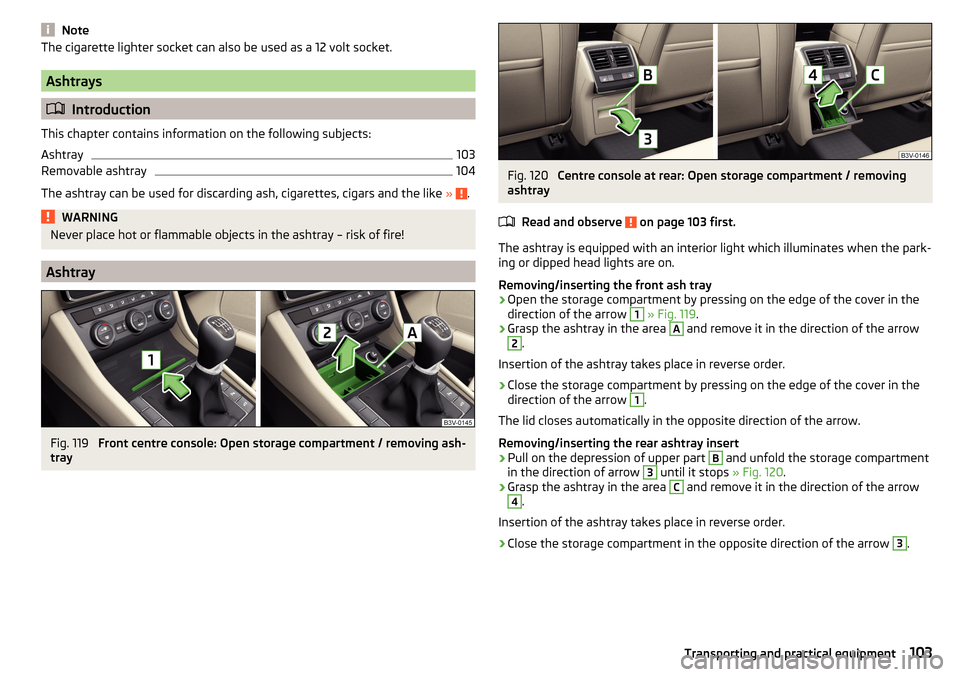
NoteThe cigarette lighter socket can also be used as a 12 volt socket.
Ashtrays
Introduction
This chapter contains information on the following subjects:
Ashtray
103
Removable ashtray
104
The ashtray can be used for discarding ash, cigarettes, cigars and the like » .
WARNINGNever place hot or flammable objects in the ashtray – risk of fire!
Ashtray
Fig. 119
Front centre console: Open storage compartment / removing ash-
tray
Fig. 120
Centre console at rear: Open storage compartment / removing
ashtray
Read and observe
on page 103 first.
The ashtray is equipped with an interior light which illuminates when the park-ing or dipped head lights are on.
Removing/inserting the front ash tray
›
Open the storage compartment by pressing on the edge of the cover in the
direction of the arrow
1
» Fig. 119 .
›
Grasp the ashtray in the area
A
and remove it in the direction of the arrow
2
.
Insertion of the ashtray takes place in reverse order.
›
Close the storage compartment by pressing on the edge of the cover in the
direction of the arrow
1
.
The lid closes automatically in the opposite direction of the arrow.
Removing/inserting the rear ashtray insert
›
Pull on the depression of upper part
B
and unfold the storage compartment
in the direction of arrow
3
until it stops » Fig. 120.
›
Grasp the ashtray in the area
C
and remove it in the direction of the arrow
4
.
Insertion of the ashtray takes place in reverse order.
›
Close the storage compartment in the opposite direction of the arrow
3
.
103Transporting and practical equipment
Page 106 of 276
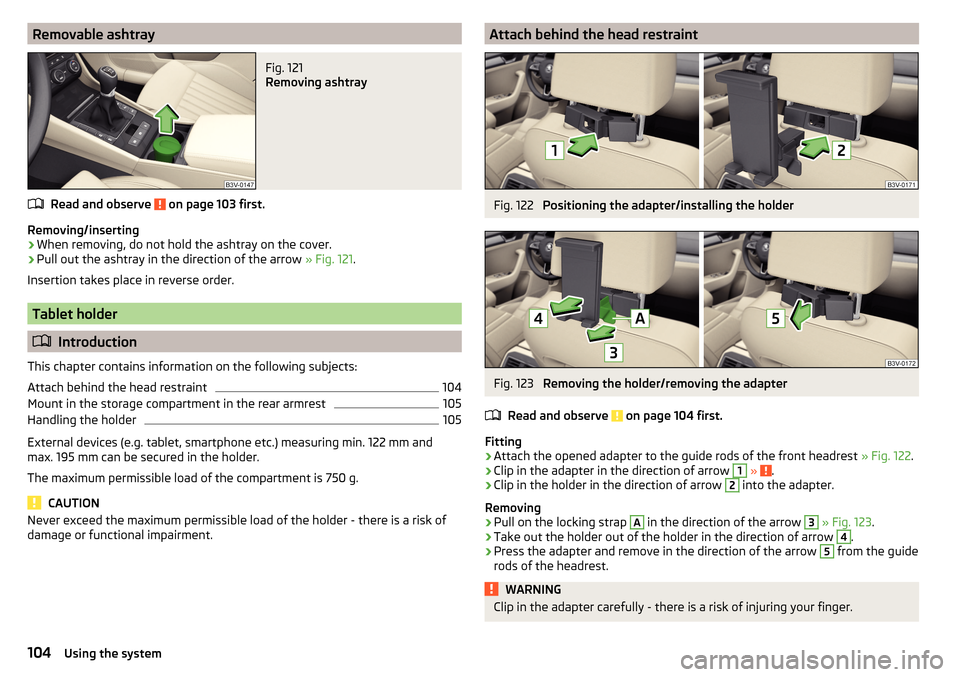
Removable ashtrayFig. 121
Removing ashtray
Read and observe on page 103 first.
Removing/inserting
›
When removing, do not hold the ashtray on the cover.
›
Pull out the ashtray in the direction of the arrow » Fig. 121.
Insertion takes place in reverse order.
Tablet holder
Introduction
This chapter contains information on the following subjects:
Attach behind the head restraint
104
Mount in the storage compartment in the rear armrest
105
Handling the holder
105
External devices (e.g. tablet, smartphone etc.) measuring min. 122 mm and
max. 195 mm can be secured in the holder.
The maximum permissible load of the compartment is 750 g.
CAUTION
Never exceed the maximum permissible load of the holder - there is a risk of
damage or functional impairment.Attach behind the head restraintFig. 122
Positioning the adapter/installing the holder
Fig. 123
Removing the holder/removing the adapter
Read and observe
on page 104 first.
Fitting
›
Attach the opened adapter to the guide rods of the front headrest » Fig. 122.
›
Clip in the adapter in the direction of arrow
1
» .
›
Clip in the holder in the direction of arrow
2
into the adapter.
Removing
›
Pull on the locking strap
A
in the direction of the arrow
3
» Fig. 123 .
›
Take out the holder out of the holder in the direction of arrow
4
.
›
Press the adapter and remove in the direction of the arrow
5
from the guide
rods of the headrest.
WARNINGClip in the adapter carefully - there is a risk of injuring your finger.104Using the system
Page 107 of 276
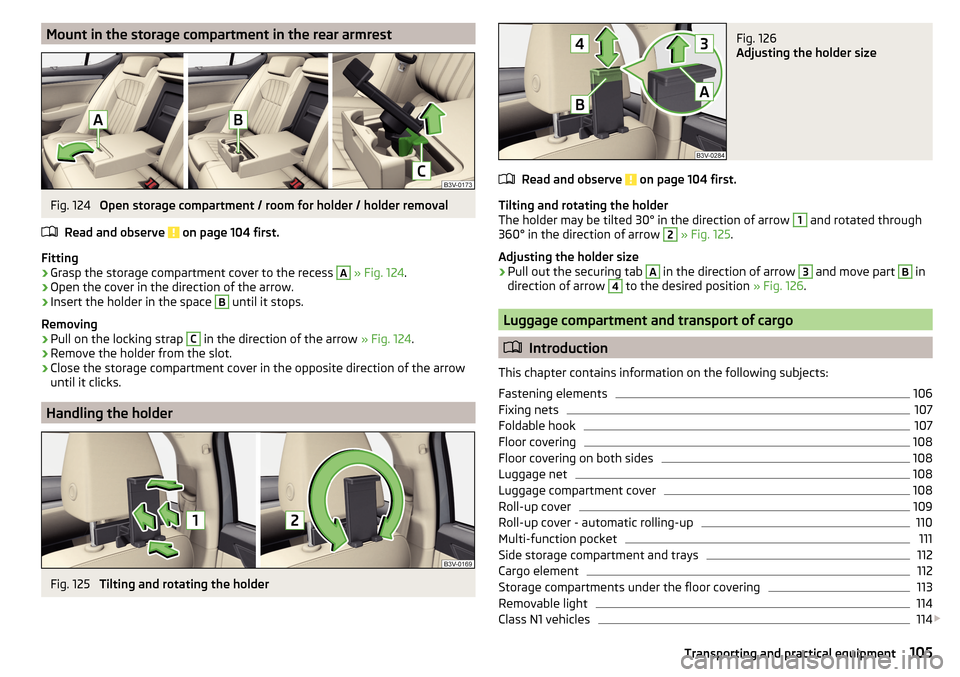
Mount in the storage compartment in the rear armrestFig. 124
Open storage compartment / room for holder / holder removal
Read and observe
on page 104 first.
Fitting
›
Grasp the storage compartment cover to the recess
A
» Fig. 124 .
›
Open the cover in the direction of the arrow.
›
Insert the holder in the space
B
until it stops.
Removing
›
Pull on the locking strap
C
in the direction of the arrow » Fig. 124.
›
Remove the holder from the slot.
›
Close the storage compartment cover in the opposite direction of the arrow
until it clicks.
Handling the holder
Fig. 125
Tilting and rotating the holder
Fig. 126
Adjusting the holder size
Read and observe on page 104 first.
Tilting and rotating the holder
The holder may be tilted 30° in the direction of arrow
1
and rotated through
360° in the direction of arrow
2
» Fig. 125 .
Adjusting the holder size
›
Pull out the securing tab
A
in the direction of arrow
3
and move part
B
in
direction of arrow
4
to the desired position » Fig. 126.
Luggage compartment and transport of cargo
Introduction
This chapter contains information on the following subjects:
Fastening elements
106
Fixing nets
107
Foldable hook
107
Floor covering
108
Floor covering on both sides
108
Luggage net
108
Luggage compartment cover
108
Roll-up cover
109
Roll-up cover - automatic rolling-up
110
Multi-function pocket
111
Side storage compartment and trays
112
Cargo element
112
Storage compartments under the floor covering
113
Removable light
114
Class N1 vehicles
114
105Transporting and practical equipment
Page 108 of 276

When transporting cargo the following the instructions must be adhered to
▶ When transporting heavy objects, the driving characteristics change due to
the shift in centre-of-gravity. The speed and style of driving must be adjus-
ted accordingly.
▶ The cargo is stowed in the luggage compartment. To prevent this from mov-
ing it should be secured with suitable lashing straps to the lashing eyes or
secured with fixing nets.
▶ Distribute loads as evenly as possible.
▶ Place heavy objects as far forward as possible.
▶ The transported items must be stowed in such a way that no objects are able
to slip forward on sudden driving or braking manoeuvres – risk of injury!
▶ Tyre pressure is to match the load.
▶ When transporting loads in the luggage compartment that has been en-
larged by folding the rear seats forward, ensure the safety of the passengers
transported on the other rear seats .
In the event of an accident, even small and light objects gain so much kinetic energy that they can cause severe injuries.
The magnitude of the kinetic energy is dependent on the speed at which the
vehicle is travelling and the weight of the object.
Example: In the event of a frontal collision at a speed of 50 km/h, an object
with a weight of 4.5 kg produces an energy, which corresponds to 20 times its
own weight. This means that it results in a weight of approx. 90 kg “ ”.
Luggage compartment light
The warning light turns on when tailgate is opened.
The warning light turns off when the tailgate is closed.
If the boot lid is open and the ignition switched off, the light will extinguish
automatically after around 10 minutes.
The luggage compartment illumination using the removable lamp » page 114.WARNING■
Never exceed the maximum permissible load of the respective fasteners,
nets, hooks etc. Heavy objects were not secured sufficiently – risk of injury!■
If the cargo is tied down with unsuitable or damaged lashing straps, inju-
ries can occur in the event of braking manoeuvres or accidents.
■
Loose cargo can be thrown forward during a sudden manoeuvre or in case
of an accident and can injure the occupants or other road users.
■
Loose cargo could hit a deployed airbag and injure occupants – danger of
death!
CAUTION■ Never exceed the maximum permissible load of the respective fasteners,
nets, hooks etc. - these could be damaged.■
Make sure that transported objects with sharp edges do not damage the
threads of the following devices. ■Rear window heater.
■ Rear window with an integrated antenna.
■ Integrated antenna in the rear side windows.
Fastening elements
Fig. 127
Fastening elements: Variant 1/ Variant 2
Read and observe
and on page 106 first.
The fasteners are located on both sides of the luggage compartment.
Overview of the fastening elements » Fig. 127
Fastening elements for fastening fixing nets
Lashing eyes for fastening items of luggage and fixing nets
The maximum permissible load for the individual lashing eyes
B
is 350 kg.
For vehicles with the variable loading floor, the luggage can only be secured
using the eyelets
B
when the variable loading floor is in the lower position
» page 115 .
AB106Using the system
Page 109 of 276
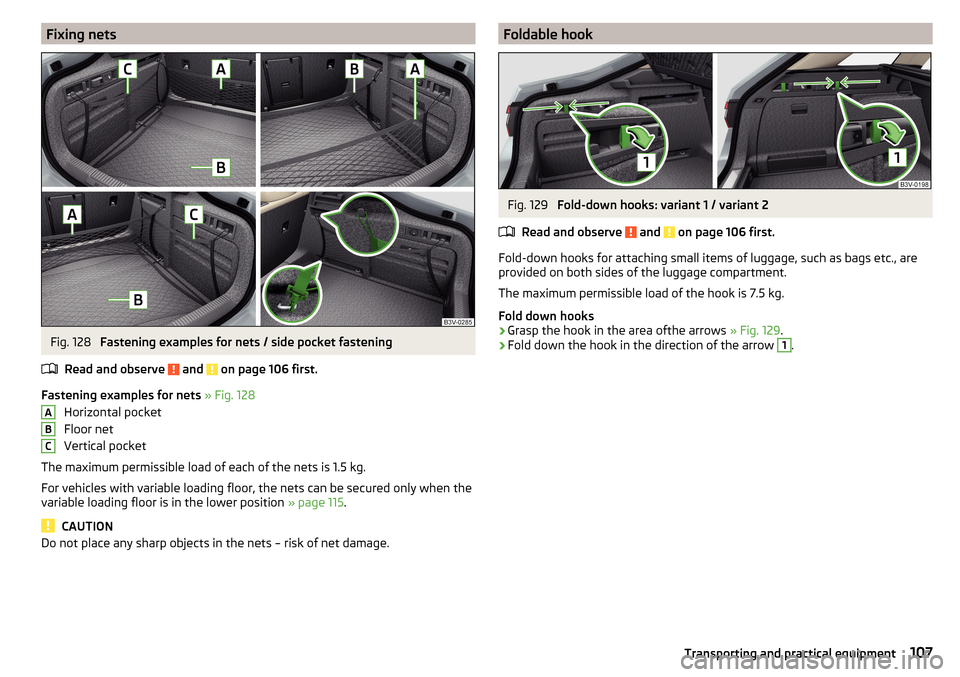
Fixing netsFig. 128
Fastening examples for nets / side pocket fastening
Read and observe
and on page 106 first.
Fastening examples for nets » Fig. 128
Horizontal pocket
Floor net
Vertical pocket
The maximum permissible load of each of the nets is 1.5 kg.
For vehicles with variable loading floor, the nets can be secured only when the
variable loading floor is in the lower position » page 115.
CAUTION
Do not place any sharp objects in the nets – risk of net damage.ABCFoldable hookFig. 129
Fold-down hooks: variant 1 / variant 2
Read and observe
and on page 106 first.
Fold-down hooks for attaching small items of luggage, such as bags etc., are provided on both sides of the luggage compartment.
The maximum permissible load of the hook is 7.5 kg.
Fold down hooks
›
Grasp the hook in the area ofthe arrows » Fig. 129.
›
Fold down the hook in the direction of the arrow
1
.
107Transporting and practical equipment
Page 110 of 276
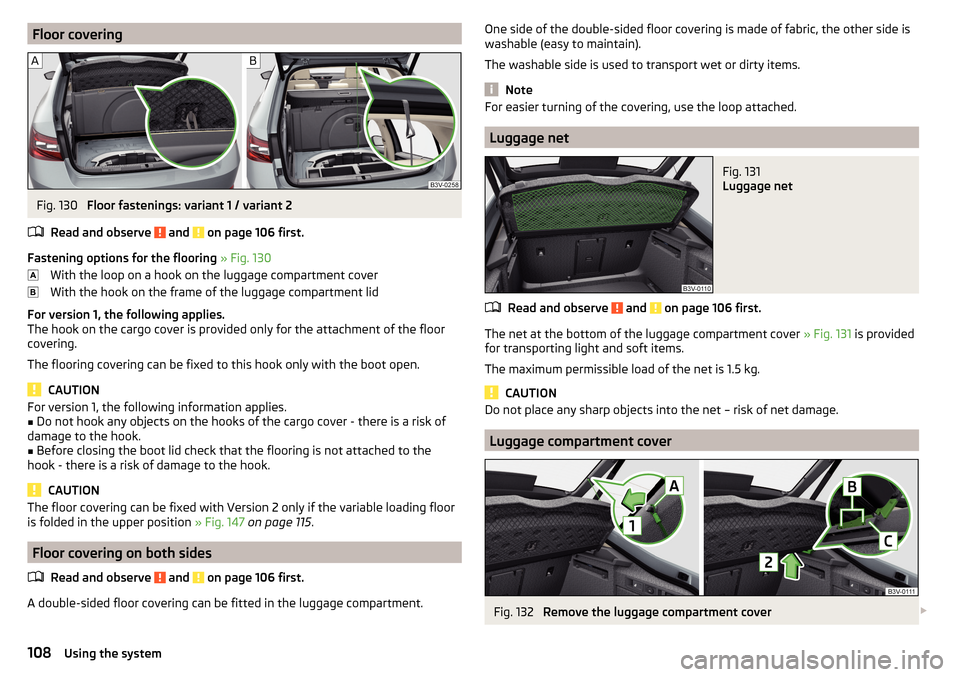
Floor coveringFig. 130
Floor fastenings: variant 1 / variant 2
Read and observe
and on page 106 first.
Fastening options for the flooring » Fig. 130
With the loop on a hook on the luggage compartment cover
With the hook on the frame of the luggage compartment lid
For version 1, the following applies.
The hook on the cargo cover is provided only for the attachment of the floor
covering.
The flooring covering can be fixed to this hook only with the boot open.
CAUTION
For version 1, the following information applies.■Do not hook any objects on the hooks of the cargo cover - there is a risk of
damage to the hook.■
Before closing the boot lid check that the flooring is not attached to the
hook - there is a risk of damage to the hook.
CAUTION
The floor covering can be fixed with Version 2 only if the variable loading floor
is folded in the upper position » Fig. 147 on page 115 .
Floor covering on both sides
Read and observe
and on page 106 first.
A double-sided floor covering can be fitted in the luggage compartment.
One side of the double-sided floor covering is made of fabric, the other side is
washable (easy to maintain).
The washable side is used to transport wet or dirty items.
Note
For easier turning of the covering, use the loop attached.
Luggage net
Fig. 131
Luggage net
Read and observe and on page 106 first.
The net at the bottom of the luggage compartment cover » Fig. 131 is provided
for transporting light and soft items.
The maximum permissible load of the net is 1.5 kg.
CAUTION
Do not place any sharp objects into the net – risk of net damage.
Luggage compartment cover
Fig. 132
Remove the luggage compartment cover
108Using the system